Report: Analyzing Managerial Roles and Organizational Interactions
VerifiedAdded on 2023/06/08
|11
|2231
|294
Report
AI Summary
This report provides an in-depth analysis of managerial roles and organizational interactions within an organization, specifically focusing on the perspective of a lab manager at Biochess research facility. It details the job description and requirements, including the necessary managerial skills and technical knowledge for ensuring lab safety and efficient operations. The report identifies key individuals and groups essential for fulfilling organizational duties, such as research scholars, suppliers, and department heads, and examines the characteristics of their interactions. It also explores the nature of interdependencies, categorizing them as pooled, reciprocal, and sequential, and evaluates the effectiveness of these interdependencies in maintaining budget limits and resolving discrepancies. The report concludes with recommendations for improving the process, such as establishing a bypass system for research scholars to order requirements and maintaining a filing system for transaction transcripts.

ASSIGNMENT
Paraphrase This Document
Need a fresh take? Get an instant paraphrase of this document with our AI Paraphraser
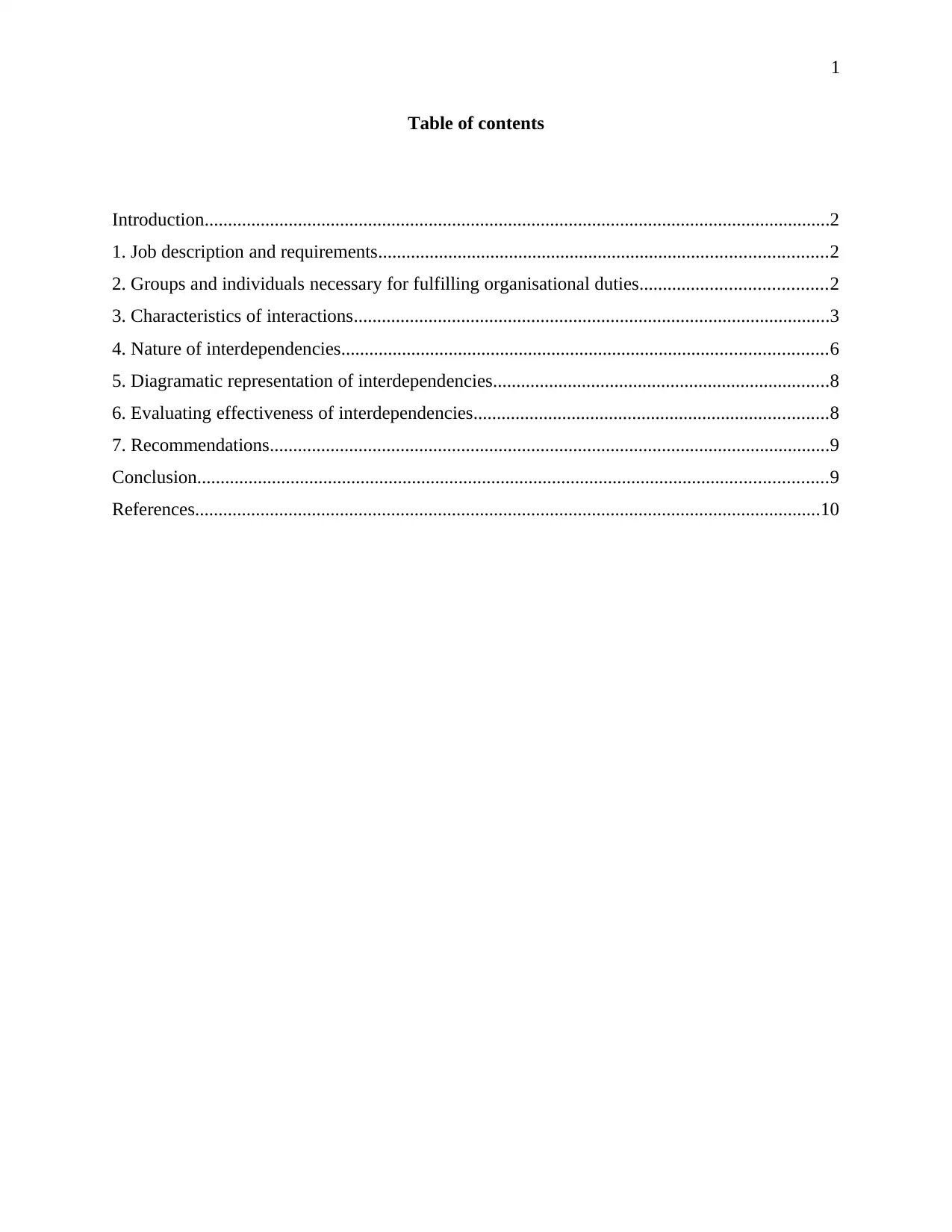
1
Table of contents
Introduction......................................................................................................................................2
1. Job description and requirements................................................................................................2
2. Groups and individuals necessary for fulfilling organisational duties........................................2
3. Characteristics of interactions......................................................................................................3
4. Nature of interdependencies........................................................................................................6
5. Diagramatic representation of interdependencies........................................................................8
6. Evaluating effectiveness of interdependencies............................................................................8
7. Recommendations........................................................................................................................9
Conclusion.......................................................................................................................................9
References......................................................................................................................................10
Table of contents
Introduction......................................................................................................................................2
1. Job description and requirements................................................................................................2
2. Groups and individuals necessary for fulfilling organisational duties........................................2
3. Characteristics of interactions......................................................................................................3
4. Nature of interdependencies........................................................................................................6
5. Diagramatic representation of interdependencies........................................................................8
6. Evaluating effectiveness of interdependencies............................................................................8
7. Recommendations........................................................................................................................9
Conclusion.......................................................................................................................................9
References......................................................................................................................................10
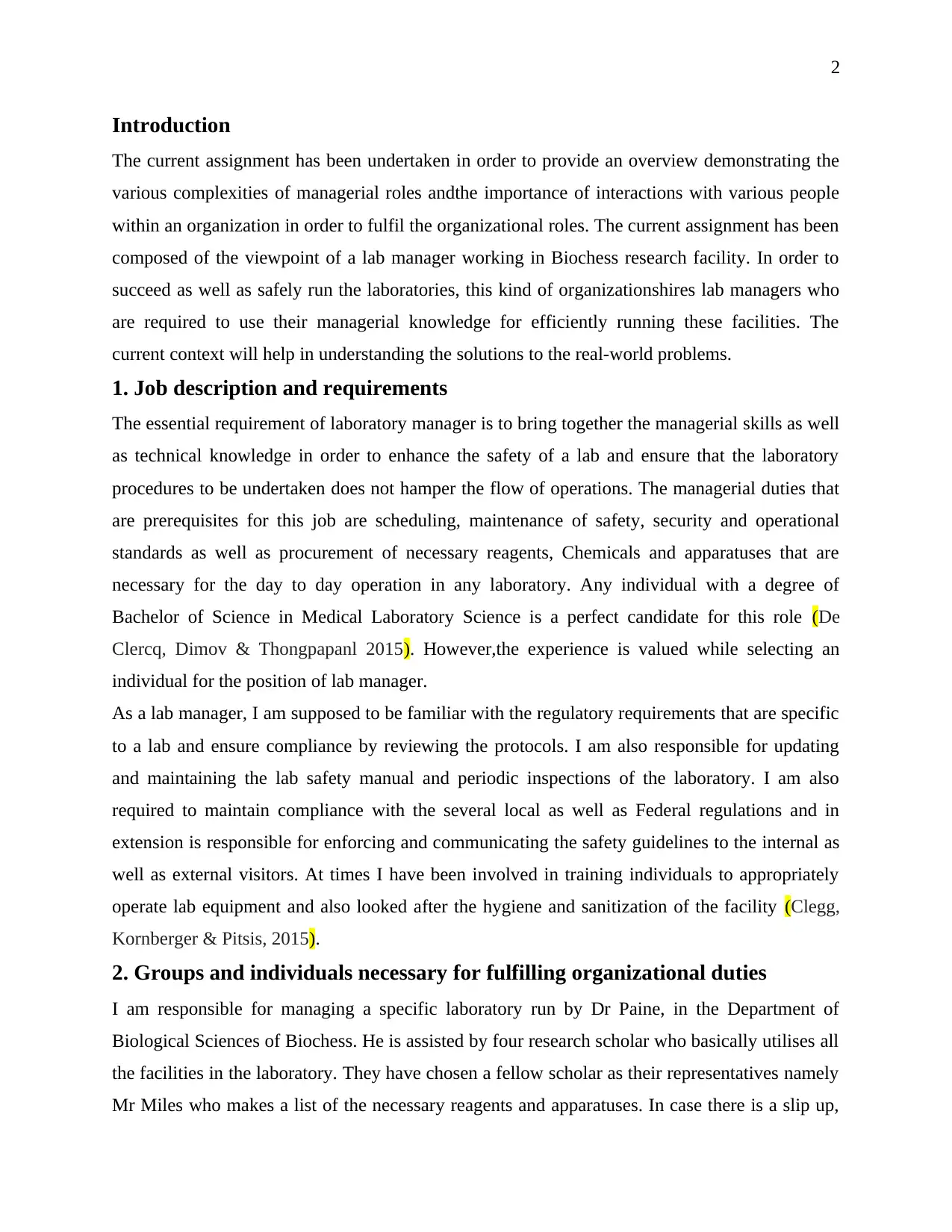
2
Introduction
The current assignment has been undertaken in order to provide an overview demonstrating the
various complexities of managerial roles andthe importance of interactions with various people
within an organization in order to fulfil the organizational roles. The current assignment has been
composed of the viewpoint of a lab manager working in Biochess research facility. In order to
succeed as well as safely run the laboratories, this kind of organizationshires lab managers who
are required to use their managerial knowledge for efficiently running these facilities. The
current context will help in understanding the solutions to the real-world problems.
1. Job description and requirements
The essential requirement of laboratory manager is to bring together the managerial skills as well
as technical knowledge in order to enhance the safety of a lab and ensure that the laboratory
procedures to be undertaken does not hamper the flow of operations. The managerial duties that
are prerequisites for this job are scheduling, maintenance of safety, security and operational
standards as well as procurement of necessary reagents, Chemicals and apparatuses that are
necessary for the day to day operation in any laboratory. Any individual with a degree of
Bachelor of Science in Medical Laboratory Science is a perfect candidate for this role (De
Clercq, Dimov & Thongpapanl 2015). However,the experience is valued while selecting an
individual for the position of lab manager.
As a lab manager, I am supposed to be familiar with the regulatory requirements that are specific
to a lab and ensure compliance by reviewing the protocols. I am also responsible for updating
and maintaining the lab safety manual and periodic inspections of the laboratory. I am also
required to maintain compliance with the several local as well as Federal regulations and in
extension is responsible for enforcing and communicating the safety guidelines to the internal as
well as external visitors. At times I have been involved in training individuals to appropriately
operate lab equipment and also looked after the hygiene and sanitization of the facility (Clegg,
Kornberger & Pitsis, 2015).
2. Groups and individuals necessary for fulfilling organizational duties
I am responsible for managing a specific laboratory run by Dr Paine, in the Department of
Biological Sciences of Biochess. He is assisted by four research scholar who basically utilises all
the facilities in the laboratory. They have chosen a fellow scholar as their representatives namely
Mr Miles who makes a list of the necessary reagents and apparatuses. In case there is a slip up,
Introduction
The current assignment has been undertaken in order to provide an overview demonstrating the
various complexities of managerial roles andthe importance of interactions with various people
within an organization in order to fulfil the organizational roles. The current assignment has been
composed of the viewpoint of a lab manager working in Biochess research facility. In order to
succeed as well as safely run the laboratories, this kind of organizationshires lab managers who
are required to use their managerial knowledge for efficiently running these facilities. The
current context will help in understanding the solutions to the real-world problems.
1. Job description and requirements
The essential requirement of laboratory manager is to bring together the managerial skills as well
as technical knowledge in order to enhance the safety of a lab and ensure that the laboratory
procedures to be undertaken does not hamper the flow of operations. The managerial duties that
are prerequisites for this job are scheduling, maintenance of safety, security and operational
standards as well as procurement of necessary reagents, Chemicals and apparatuses that are
necessary for the day to day operation in any laboratory. Any individual with a degree of
Bachelor of Science in Medical Laboratory Science is a perfect candidate for this role (De
Clercq, Dimov & Thongpapanl 2015). However,the experience is valued while selecting an
individual for the position of lab manager.
As a lab manager, I am supposed to be familiar with the regulatory requirements that are specific
to a lab and ensure compliance by reviewing the protocols. I am also responsible for updating
and maintaining the lab safety manual and periodic inspections of the laboratory. I am also
required to maintain compliance with the several local as well as Federal regulations and in
extension is responsible for enforcing and communicating the safety guidelines to the internal as
well as external visitors. At times I have been involved in training individuals to appropriately
operate lab equipment and also looked after the hygiene and sanitization of the facility (Clegg,
Kornberger & Pitsis, 2015).
2. Groups and individuals necessary for fulfilling organizational duties
I am responsible for managing a specific laboratory run by Dr Paine, in the Department of
Biological Sciences of Biochess. He is assisted by four research scholar who basically utilises all
the facilities in the laboratory. They have chosen a fellow scholar as their representatives namely
Mr Miles who makes a list of the necessary reagents and apparatuses. In case there is a slip up,
⊘ This is a preview!⊘
Do you want full access?
Subscribe today to unlock all pages.

Trusted by 1+ million students worldwide
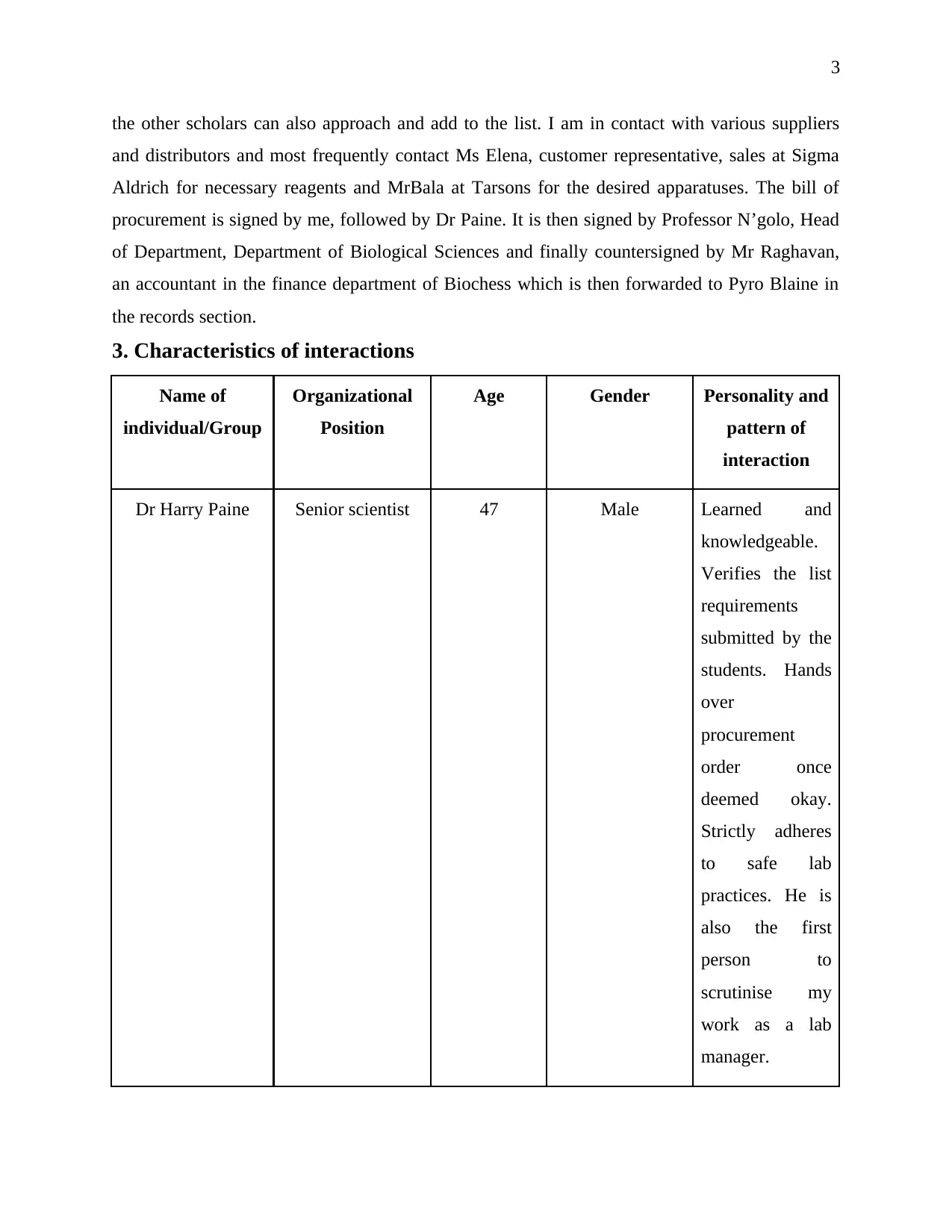
3
the other scholars can also approach and add to the list. I am in contact with various suppliers
and distributors and most frequently contact Ms Elena, customer representative, sales at Sigma
Aldrich for necessary reagents and MrBala at Tarsons for the desired apparatuses. The bill of
procurement is signed by me, followed by Dr Paine. It is then signed by Professor N’golo, Head
of Department, Department of Biological Sciences and finally countersigned by Mr Raghavan,
an accountant in the finance department of Biochess which is then forwarded to Pyro Blaine in
the records section.
3. Characteristics of interactions
Name of
individual/Group
Organizational
Position
Age Gender Personality and
pattern of
interaction
Dr Harry Paine Senior scientist 47 Male Learned and
knowledgeable.
Verifies the list
requirements
submitted by the
students. Hands
over
procurement
order once
deemed okay.
Strictly adheres
to safe lab
practices. He is
also the first
person to
scrutinise my
work as a lab
manager.
the other scholars can also approach and add to the list. I am in contact with various suppliers
and distributors and most frequently contact Ms Elena, customer representative, sales at Sigma
Aldrich for necessary reagents and MrBala at Tarsons for the desired apparatuses. The bill of
procurement is signed by me, followed by Dr Paine. It is then signed by Professor N’golo, Head
of Department, Department of Biological Sciences and finally countersigned by Mr Raghavan,
an accountant in the finance department of Biochess which is then forwarded to Pyro Blaine in
the records section.
3. Characteristics of interactions
Name of
individual/Group
Organizational
Position
Age Gender Personality and
pattern of
interaction
Dr Harry Paine Senior scientist 47 Male Learned and
knowledgeable.
Verifies the list
requirements
submitted by the
students. Hands
over
procurement
order once
deemed okay.
Strictly adheres
to safe lab
practices. He is
also the first
person to
scrutinise my
work as a lab
manager.
Paraphrase This Document
Need a fresh take? Get an instant paraphrase of this document with our AI Paraphraser
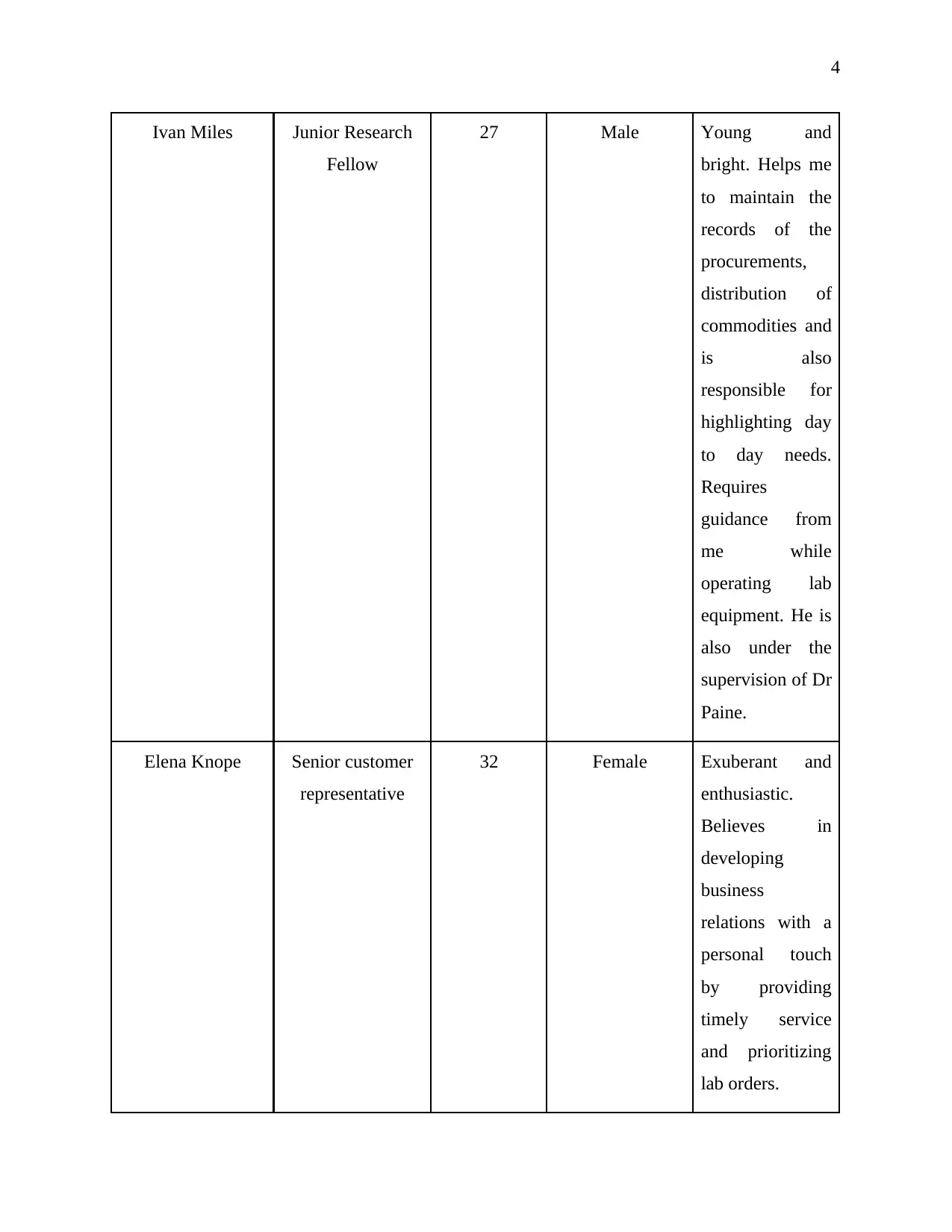
4
Ivan Miles Junior Research
Fellow
27 Male Young and
bright. Helps me
to maintain the
records of the
procurements,
distribution of
commodities and
is also
responsible for
highlighting day
to day needs.
Requires
guidance from
me while
operating lab
equipment. He is
also under the
supervision of Dr
Paine.
Elena Knope Senior customer
representative
32 Female Exuberant and
enthusiastic.
Believes in
developing
business
relations with a
personal touch
by providing
timely service
and prioritizing
lab orders.
Ivan Miles Junior Research
Fellow
27 Male Young and
bright. Helps me
to maintain the
records of the
procurements,
distribution of
commodities and
is also
responsible for
highlighting day
to day needs.
Requires
guidance from
me while
operating lab
equipment. He is
also under the
supervision of Dr
Paine.
Elena Knope Senior customer
representative
32 Female Exuberant and
enthusiastic.
Believes in
developing
business
relations with a
personal touch
by providing
timely service
and prioritizing
lab orders.
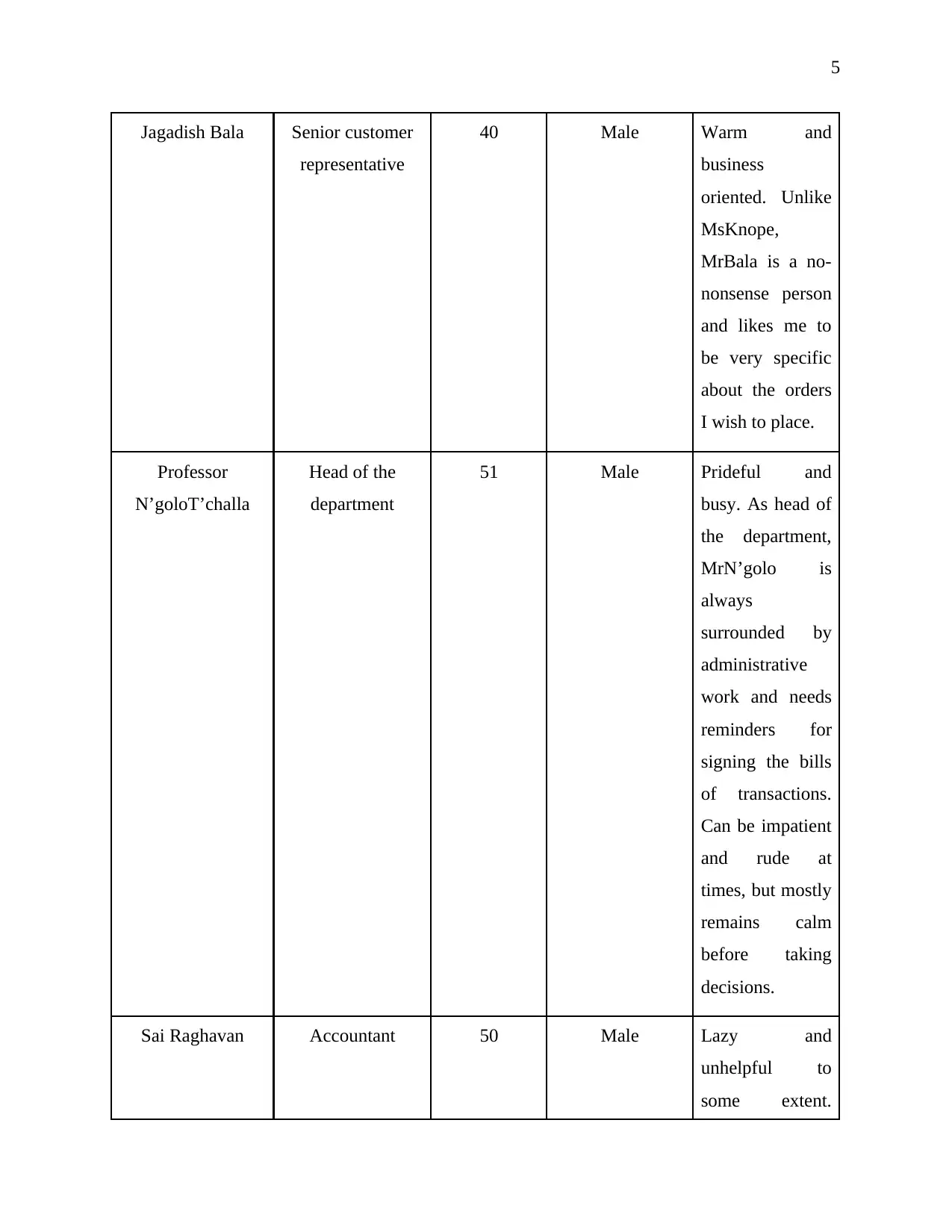
5
Jagadish Bala Senior customer
representative
40 Male Warm and
business
oriented. Unlike
MsKnope,
MrBala is a no-
nonsense person
and likes me to
be very specific
about the orders
I wish to place.
Professor
N’goloT’challa
Head of the
department
51 Male Prideful and
busy. As head of
the department,
MrN’golo is
always
surrounded by
administrative
work and needs
reminders for
signing the bills
of transactions.
Can be impatient
and rude at
times, but mostly
remains calm
before taking
decisions.
Sai Raghavan Accountant 50 Male Lazy and
unhelpful to
some extent.
Jagadish Bala Senior customer
representative
40 Male Warm and
business
oriented. Unlike
MsKnope,
MrBala is a no-
nonsense person
and likes me to
be very specific
about the orders
I wish to place.
Professor
N’goloT’challa
Head of the
department
51 Male Prideful and
busy. As head of
the department,
MrN’golo is
always
surrounded by
administrative
work and needs
reminders for
signing the bills
of transactions.
Can be impatient
and rude at
times, but mostly
remains calm
before taking
decisions.
Sai Raghavan Accountant 50 Male Lazy and
unhelpful to
some extent.
⊘ This is a preview!⊘
Do you want full access?
Subscribe today to unlock all pages.

Trusted by 1+ million students worldwide
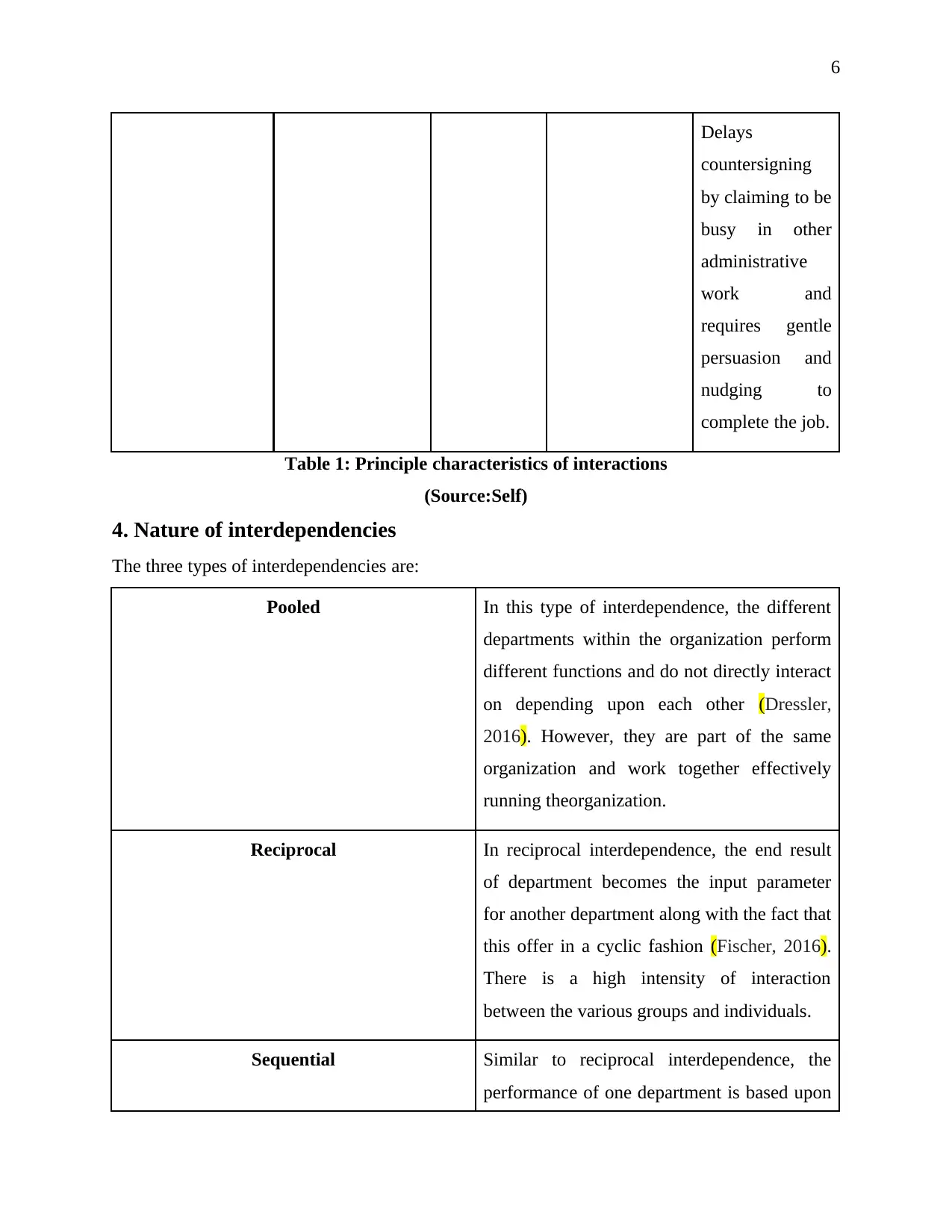
6
Delays
countersigning
by claiming to be
busy in other
administrative
work and
requires gentle
persuasion and
nudging to
complete the job.
Table 1: Principle characteristics of interactions
(Source:Self)
4. Nature of interdependencies
The three types of interdependencies are:
Pooled In this type of interdependence, the different
departments within the organization perform
different functions and do not directly interact
on depending upon each other (Dressler,
2016). However, they are part of the same
organization and work together effectively
running theorganization.
Reciprocal In reciprocal interdependence, the end result
of department becomes the input parameter
for another department along with the fact that
this offer in a cyclic fashion (Fischer, 2016).
There is a high intensity of interaction
between the various groups and individuals.
Sequential Similar to reciprocal interdependence, the
performance of one department is based upon
Delays
countersigning
by claiming to be
busy in other
administrative
work and
requires gentle
persuasion and
nudging to
complete the job.
Table 1: Principle characteristics of interactions
(Source:Self)
4. Nature of interdependencies
The three types of interdependencies are:
Pooled In this type of interdependence, the different
departments within the organization perform
different functions and do not directly interact
on depending upon each other (Dressler,
2016). However, they are part of the same
organization and work together effectively
running theorganization.
Reciprocal In reciprocal interdependence, the end result
of department becomes the input parameter
for another department along with the fact that
this offer in a cyclic fashion (Fischer, 2016).
There is a high intensity of interaction
between the various groups and individuals.
Sequential Similar to reciprocal interdependence, the
performance of one department is based upon
Paraphrase This Document
Need a fresh take? Get an instant paraphrase of this document with our AI Paraphraser
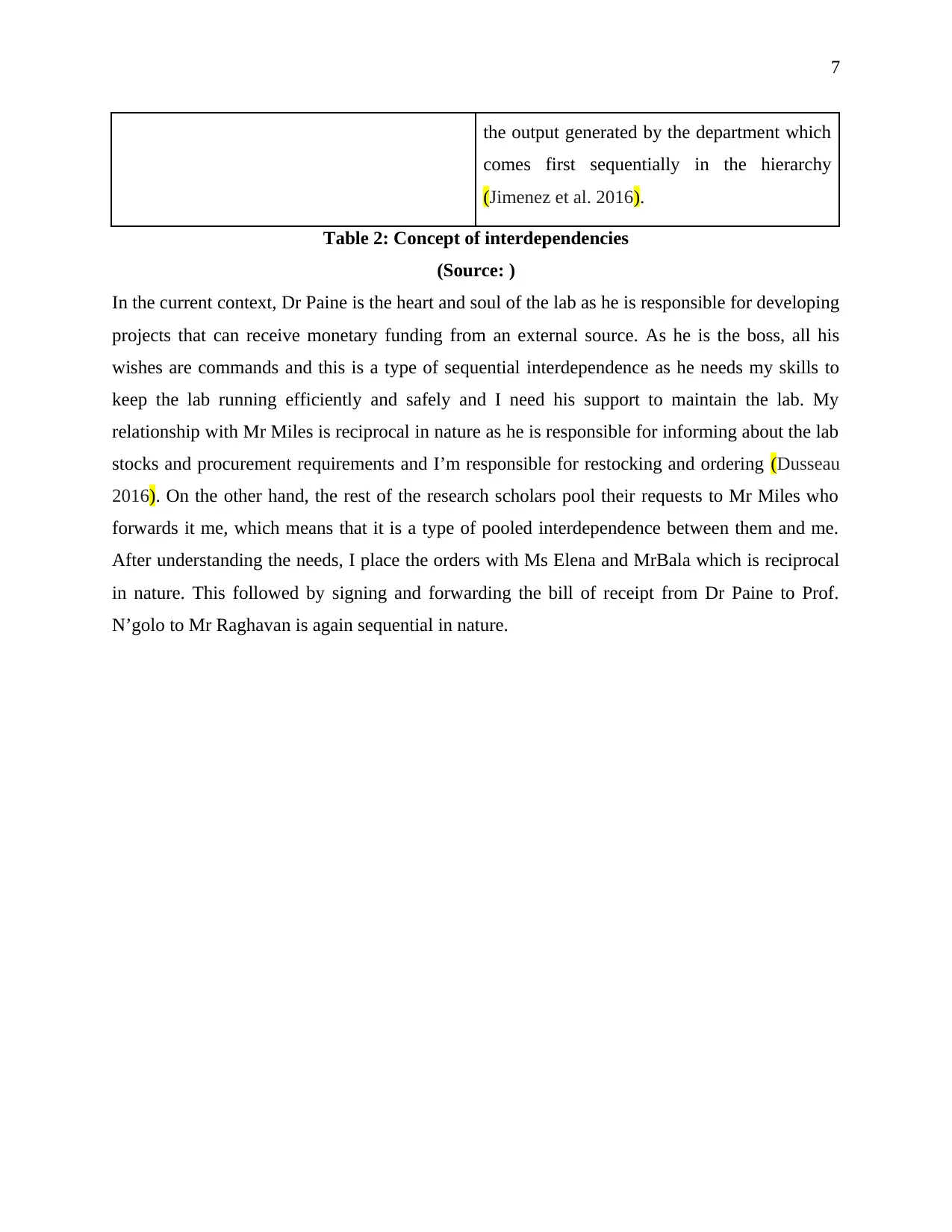
7
the output generated by the department which
comes first sequentially in the hierarchy
(Jimenez et al. 2016).
Table 2: Concept of interdependencies
(Source: )
In the current context, Dr Paine is the heart and soul of the lab as he is responsible for developing
projects that can receive monetary funding from an external source. As he is the boss, all his
wishes are commands and this is a type of sequential interdependence as he needs my skills to
keep the lab running efficiently and safely and I need his support to maintain the lab. My
relationship with Mr Miles is reciprocal in nature as he is responsible for informing about the lab
stocks and procurement requirements and I’m responsible for restocking and ordering (Dusseau
2016). On the other hand, the rest of the research scholars pool their requests to Mr Miles who
forwards it me, which means that it is a type of pooled interdependence between them and me.
After understanding the needs, I place the orders with Ms Elena and MrBala which is reciprocal
in nature. This followed by signing and forwarding the bill of receipt from Dr Paine to Prof.
N’golo to Mr Raghavan is again sequential in nature.
the output generated by the department which
comes first sequentially in the hierarchy
(Jimenez et al. 2016).
Table 2: Concept of interdependencies
(Source: )
In the current context, Dr Paine is the heart and soul of the lab as he is responsible for developing
projects that can receive monetary funding from an external source. As he is the boss, all his
wishes are commands and this is a type of sequential interdependence as he needs my skills to
keep the lab running efficiently and safely and I need his support to maintain the lab. My
relationship with Mr Miles is reciprocal in nature as he is responsible for informing about the lab
stocks and procurement requirements and I’m responsible for restocking and ordering (Dusseau
2016). On the other hand, the rest of the research scholars pool their requests to Mr Miles who
forwards it me, which means that it is a type of pooled interdependence between them and me.
After understanding the needs, I place the orders with Ms Elena and MrBala which is reciprocal
in nature. This followed by signing and forwarding the bill of receipt from Dr Paine to Prof.
N’golo to Mr Raghavan is again sequential in nature.
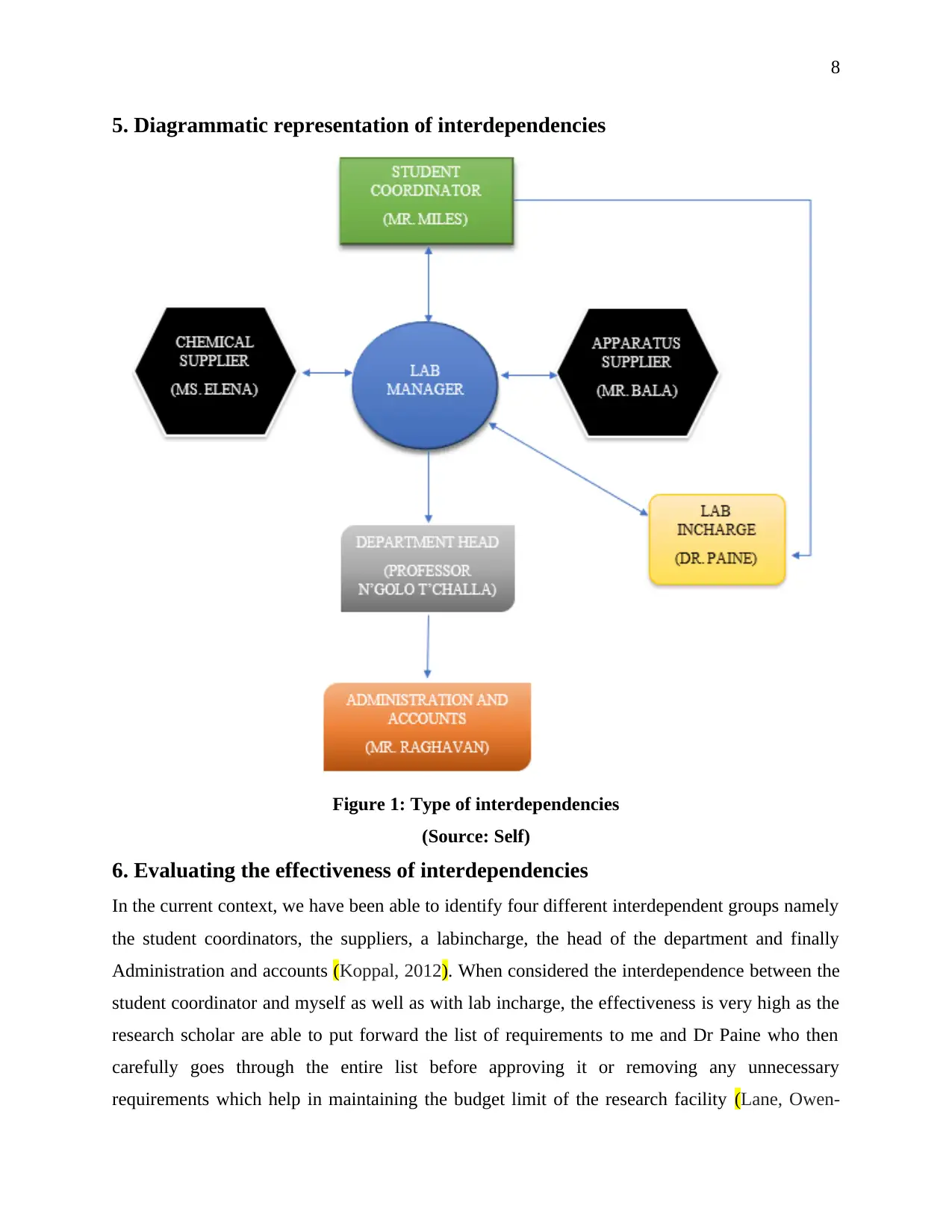
8
5. Diagrammatic representation of interdependencies
Figure 1: Type of interdependencies
(Source: Self)
6. Evaluating the effectiveness of interdependencies
In the current context, we have been able to identify four different interdependent groups namely
the student coordinators, the suppliers, a labincharge, the head of the department and finally
Administration and accounts (Koppal, 2012). When considered the interdependence between the
student coordinator and myself as well as with lab incharge, the effectiveness is very high as the
research scholar are able to put forward the list of requirements to me and Dr Paine who then
carefully goes through the entire list before approving it or removing any unnecessary
requirements which help in maintaining the budget limit of the research facility (Lane, Owen-
5. Diagrammatic representation of interdependencies
Figure 1: Type of interdependencies
(Source: Self)
6. Evaluating the effectiveness of interdependencies
In the current context, we have been able to identify four different interdependent groups namely
the student coordinators, the suppliers, a labincharge, the head of the department and finally
Administration and accounts (Koppal, 2012). When considered the interdependence between the
student coordinator and myself as well as with lab incharge, the effectiveness is very high as the
research scholar are able to put forward the list of requirements to me and Dr Paine who then
carefully goes through the entire list before approving it or removing any unnecessary
requirements which help in maintaining the budget limit of the research facility (Lane, Owen-
⊘ This is a preview!⊘
Do you want full access?
Subscribe today to unlock all pages.

Trusted by 1+ million students worldwide
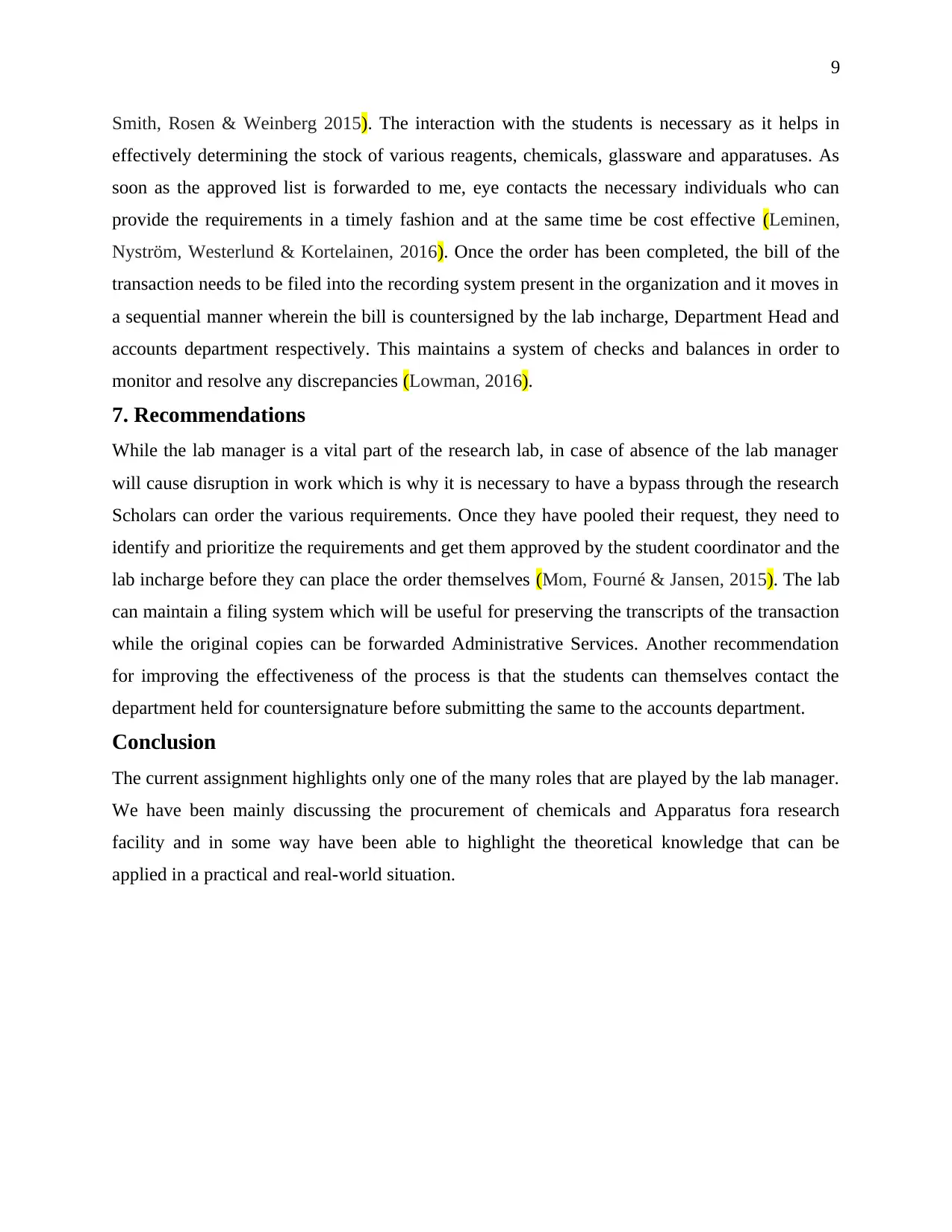
9
Smith, Rosen & Weinberg 2015). The interaction with the students is necessary as it helps in
effectively determining the stock of various reagents, chemicals, glassware and apparatuses. As
soon as the approved list is forwarded to me, eye contacts the necessary individuals who can
provide the requirements in a timely fashion and at the same time be cost effective (Leminen,
Nyström, Westerlund & Kortelainen, 2016). Once the order has been completed, the bill of the
transaction needs to be filed into the recording system present in the organization and it moves in
a sequential manner wherein the bill is countersigned by the lab incharge, Department Head and
accounts department respectively. This maintains a system of checks and balances in order to
monitor and resolve any discrepancies (Lowman, 2016).
7. Recommendations
While the lab manager is a vital part of the research lab, in case of absence of the lab manager
will cause disruption in work which is why it is necessary to have a bypass through the research
Scholars can order the various requirements. Once they have pooled their request, they need to
identify and prioritize the requirements and get them approved by the student coordinator and the
lab incharge before they can place the order themselves (Mom, Fourné & Jansen, 2015). The lab
can maintain a filing system which will be useful for preserving the transcripts of the transaction
while the original copies can be forwarded Administrative Services. Another recommendation
for improving the effectiveness of the process is that the students can themselves contact the
department held for countersignature before submitting the same to the accounts department.
Conclusion
The current assignment highlights only one of the many roles that are played by the lab manager.
We have been mainly discussing the procurement of chemicals and Apparatus fora research
facility and in some way have been able to highlight the theoretical knowledge that can be
applied in a practical and real-world situation.
Smith, Rosen & Weinberg 2015). The interaction with the students is necessary as it helps in
effectively determining the stock of various reagents, chemicals, glassware and apparatuses. As
soon as the approved list is forwarded to me, eye contacts the necessary individuals who can
provide the requirements in a timely fashion and at the same time be cost effective (Leminen,
Nyström, Westerlund & Kortelainen, 2016). Once the order has been completed, the bill of the
transaction needs to be filed into the recording system present in the organization and it moves in
a sequential manner wherein the bill is countersigned by the lab incharge, Department Head and
accounts department respectively. This maintains a system of checks and balances in order to
monitor and resolve any discrepancies (Lowman, 2016).
7. Recommendations
While the lab manager is a vital part of the research lab, in case of absence of the lab manager
will cause disruption in work which is why it is necessary to have a bypass through the research
Scholars can order the various requirements. Once they have pooled their request, they need to
identify and prioritize the requirements and get them approved by the student coordinator and the
lab incharge before they can place the order themselves (Mom, Fourné & Jansen, 2015). The lab
can maintain a filing system which will be useful for preserving the transcripts of the transaction
while the original copies can be forwarded Administrative Services. Another recommendation
for improving the effectiveness of the process is that the students can themselves contact the
department held for countersignature before submitting the same to the accounts department.
Conclusion
The current assignment highlights only one of the many roles that are played by the lab manager.
We have been mainly discussing the procurement of chemicals and Apparatus fora research
facility and in some way have been able to highlight the theoretical knowledge that can be
applied in a practical and real-world situation.
Paraphrase This Document
Need a fresh take? Get an instant paraphrase of this document with our AI Paraphraser
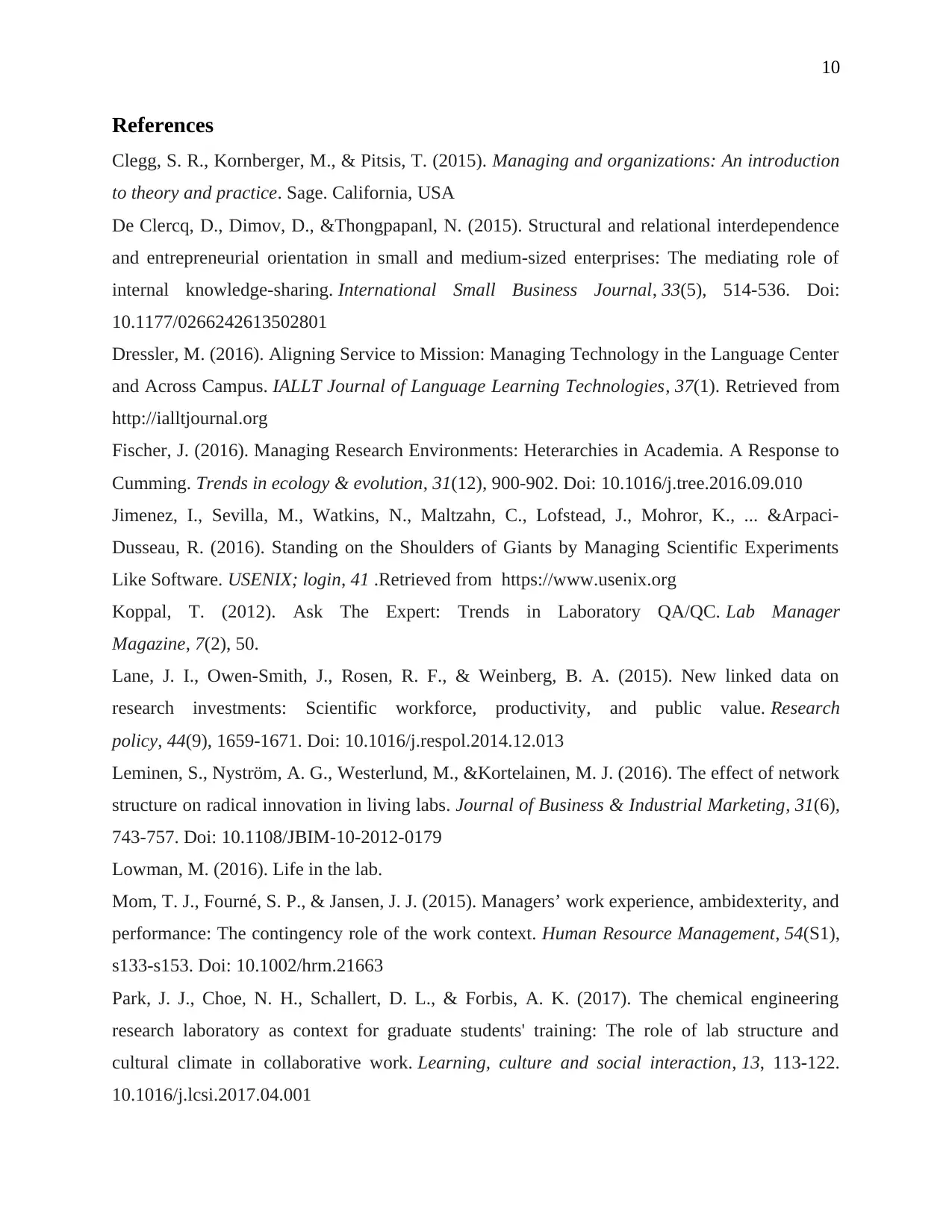
10
References
Clegg, S. R., Kornberger, M., & Pitsis, T. (2015). Managing and organizations: An introduction
to theory and practice. Sage. California, USA
De Clercq, D., Dimov, D., &Thongpapanl, N. (2015). Structural and relational interdependence
and entrepreneurial orientation in small and medium-sized enterprises: The mediating role of
internal knowledge-sharing. International Small Business Journal, 33(5), 514-536. Doi:
10.1177/0266242613502801
Dressler, M. (2016). Aligning Service to Mission: Managing Technology in the Language Center
and Across Campus. IALLT Journal of Language Learning Technologies, 37(1). Retrieved from
http://ialltjournal.org
Fischer, J. (2016). Managing Research Environments: Heterarchies in Academia. A Response to
Cumming. Trends in ecology & evolution, 31(12), 900-902. Doi: 10.1016/j.tree.2016.09.010
Jimenez, I., Sevilla, M., Watkins, N., Maltzahn, C., Lofstead, J., Mohror, K., ... &Arpaci-
Dusseau, R. (2016). Standing on the Shoulders of Giants by Managing Scientific Experiments
Like Software. USENIX; login, 41 .Retrieved from https://www.usenix.org
Koppal, T. (2012). Ask The Expert: Trends in Laboratory QA/QC. Lab Manager
Magazine, 7(2), 50.
Lane, J. I., Owen-Smith, J., Rosen, R. F., & Weinberg, B. A. (2015). New linked data on
research investments: Scientific workforce, productivity, and public value. Research
policy, 44(9), 1659-1671. Doi: 10.1016/j.respol.2014.12.013
Leminen, S., Nyström, A. G., Westerlund, M., &Kortelainen, M. J. (2016). The effect of network
structure on radical innovation in living labs. Journal of Business & Industrial Marketing, 31(6),
743-757. Doi: 10.1108/JBIM-10-2012-0179
Lowman, M. (2016). Life in the lab.
Mom, T. J., Fourné, S. P., & Jansen, J. J. (2015). Managers’ work experience, ambidexterity, and
performance: The contingency role of the work context. Human Resource Management, 54(S1),
s133-s153. Doi: 10.1002/hrm.21663
Park, J. J., Choe, N. H., Schallert, D. L., & Forbis, A. K. (2017). The chemical engineering
research laboratory as context for graduate students' training: The role of lab structure and
cultural climate in collaborative work. Learning, culture and social interaction, 13, 113-122.
10.1016/j.lcsi.2017.04.001
References
Clegg, S. R., Kornberger, M., & Pitsis, T. (2015). Managing and organizations: An introduction
to theory and practice. Sage. California, USA
De Clercq, D., Dimov, D., &Thongpapanl, N. (2015). Structural and relational interdependence
and entrepreneurial orientation in small and medium-sized enterprises: The mediating role of
internal knowledge-sharing. International Small Business Journal, 33(5), 514-536. Doi:
10.1177/0266242613502801
Dressler, M. (2016). Aligning Service to Mission: Managing Technology in the Language Center
and Across Campus. IALLT Journal of Language Learning Technologies, 37(1). Retrieved from
http://ialltjournal.org
Fischer, J. (2016). Managing Research Environments: Heterarchies in Academia. A Response to
Cumming. Trends in ecology & evolution, 31(12), 900-902. Doi: 10.1016/j.tree.2016.09.010
Jimenez, I., Sevilla, M., Watkins, N., Maltzahn, C., Lofstead, J., Mohror, K., ... &Arpaci-
Dusseau, R. (2016). Standing on the Shoulders of Giants by Managing Scientific Experiments
Like Software. USENIX; login, 41 .Retrieved from https://www.usenix.org
Koppal, T. (2012). Ask The Expert: Trends in Laboratory QA/QC. Lab Manager
Magazine, 7(2), 50.
Lane, J. I., Owen-Smith, J., Rosen, R. F., & Weinberg, B. A. (2015). New linked data on
research investments: Scientific workforce, productivity, and public value. Research
policy, 44(9), 1659-1671. Doi: 10.1016/j.respol.2014.12.013
Leminen, S., Nyström, A. G., Westerlund, M., &Kortelainen, M. J. (2016). The effect of network
structure on radical innovation in living labs. Journal of Business & Industrial Marketing, 31(6),
743-757. Doi: 10.1108/JBIM-10-2012-0179
Lowman, M. (2016). Life in the lab.
Mom, T. J., Fourné, S. P., & Jansen, J. J. (2015). Managers’ work experience, ambidexterity, and
performance: The contingency role of the work context. Human Resource Management, 54(S1),
s133-s153. Doi: 10.1002/hrm.21663
Park, J. J., Choe, N. H., Schallert, D. L., & Forbis, A. K. (2017). The chemical engineering
research laboratory as context for graduate students' training: The role of lab structure and
cultural climate in collaborative work. Learning, culture and social interaction, 13, 113-122.
10.1016/j.lcsi.2017.04.001
1 out of 11
Related Documents
Your All-in-One AI-Powered Toolkit for Academic Success.
+13062052269
info@desklib.com
Available 24*7 on WhatsApp / Email
![[object Object]](/_next/static/media/star-bottom.7253800d.svg)
Unlock your academic potential
Copyright © 2020–2025 A2Z Services. All Rights Reserved. Developed and managed by ZUCOL.




